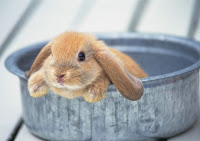
The same luxurious, warm fur that protects your rabbit in winter can overheat him in temperatures above 80 degrees Fahrenheit. Learn the signs of life-threatening heatstroke so you can rapidly intervene. Also collect some tips for prevention and treatment of heatstroke.
Red Flags
- Lethargy. If your rabbit doesn't want to move as much as usual, or can't be tempted to move by its usual motivators, continue to assess its health.
- Slow movements. If the rabbit doesn't move at its usual speed, but pads sleepily along, keep looking.
- Lack of appetite. One early sign of heat stroke is less-than-usual consumption of rabbit chow, or no eating at all.
- Panting. Is the rabbit working hard to breathe without exercising, or panting? He could be trying to cool himself down.
- Dehydration. Dry mouth, dull eyes and strong, concentrated urine are signs of this condition.
- Reddening of the ears. Check the concave, normally pink side of the bunny ears. If it's red, it's a sure sign that it's trying to cool itself.
- Excessive Salivation. If your rabbit has drool on his chin, he's salivating too much.
- Poor coordination. The movements will not be synchronized, leading to clumsiness.
- Confusion. The rabbit's behavior will not be logical or usual.
- Seizures. This will look like severe, violent shaking. It is a veterinary emergency.
- Unresponsiveness. The rabbit will not try to defend itself even from uncomfortable or painful stimuli. This is also a veterinary emergency.
Emergency Stabilization
- Move the rabbit to a cooler away from the sun. The basement is a good choice.
- Mist the pink (red) sides of the ears with cool water.
- As an alternative, cool the ears with an ice cube that's been wrapped in a thin cloth.
- Bathe the rabbit in room temperature, not cold, water only up to the neck. Do not submerge it.
- Feed wet vegetables, if the bunny will eat, and supply cold water.
- Blow a fan near the rabbit, but not directly on it.
- Call your veterinarian immediately.
Prevention
- Groom the rabbit regularly to remove loose fur.
- Keep the rabbit away from sunlight and out of hot areas.
- Provide fresh, clean water at all times.
- Run a fan in the area but not directly blowing on the rabbit.
- Supervise him in warm weather.
- Freeze water in an empty soda bottle and lay it in the cage. The bunny will cool itself next to it.
Author: Lisa Bonanno

إرسال تعليق